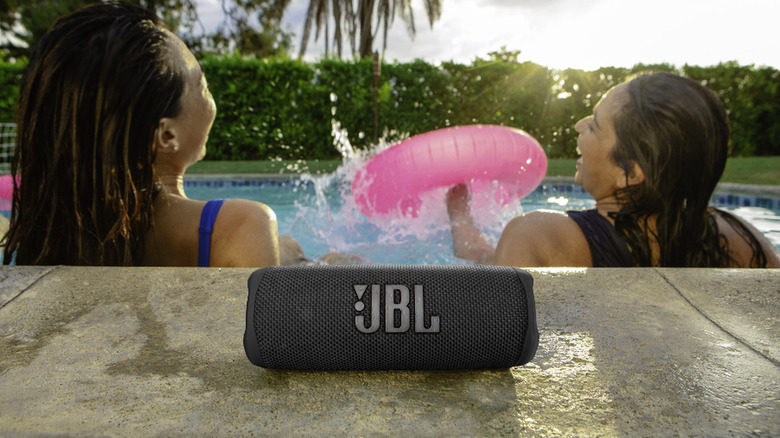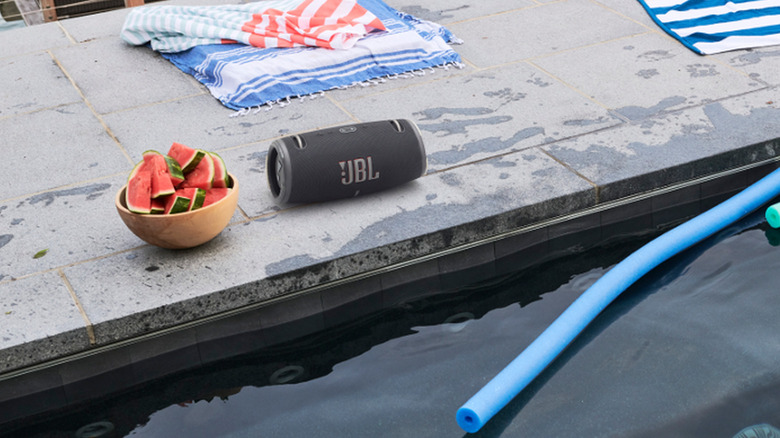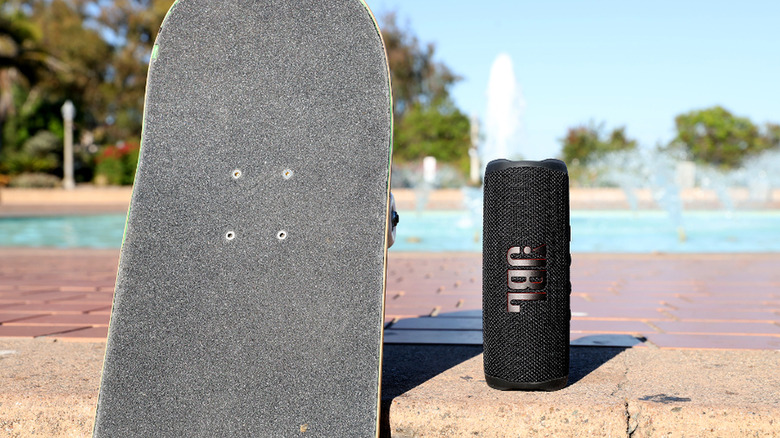Are JBL Speakers Waterproof? IP Ratings, Explained
The popular consumer audio brand JBL is known for a wide range of punchy Bluetooth speakers. Commonly found at cookouts, campsites, and college campuses, JBL speakers are known for their bass-heavy sound signatures, long battery life, and playful designs. They're often marketed as lifestyle devices that are meant to accompany pool parties, hikes, and more, which means they sport rugged-looking designs. But can these speakers actually take a splash? For that matter, what about other devices like smartwatches that make waterproof claims?
You've probably wondered how close to water you should risk taking your speaker, or perhaps felt a jolt of panic as it gets soaked. Well, the good news is that many JBL speakers can withstand some water, but the bad news is that you still shouldn't let your water-resistant devices take a dive. While some JBL speakers are water-resistant, many are not. The company makes a wide range of Bluetooth speakers that are meant for different purposes, and while some of its most rugged and portable audio playback devices are advertised as "waterproof," there are plenty of products in its lineup that will get ruined if you leave them in the rain.
In general, JBL's handheld, Bluetooth-powered speakers tend to have water resistance. Product lines such as the JBL Go, Xtreme, Charge, and Clip contain speakers advertised as "waterproof." Meanwhile, JBL's larger offerings such as its Partybox line of portable jukeboxes do not come with those claims. However, the term waterproof is a bit of a misnomer — no device is fully waterproof in the most literal sense of the word. So, how much water can your JBL speaker (and other gadgets that claim to withstand a dunk) actually handle? Here's how water resistance ratings work.
Waterproofing is a misnomer: here's how IP ratings actually work
You may have noticed that this article has not claimed JBL speakers are "waterproof," but instead uses the term "water-resistant" where applicable. That's because waterproofing is a somewhat misleading word when discussing protection against aquatic ingress into an electronic device. If you rely on the dictionary definition of waterproof, meaning impervious to water, then the truth is that no electronic device meets that standard (though some, like specialized diving equipment, get close). While some devices can withstand tremendous amounts of water pressure, there is always a limit to that endurance. For that reason, the IP rating system was developed by the International Electrotechnical Commission. IP stands for "ingress protection," and it tells consumers how protected their devices are against dust and water.
IP ratings for phones, speakers, and other electronics are expressed as IPXX, where the first X value represents dust protection and the second represents water protection. The water ingress rating is on a scale from 0-9, with 0 meaning no protection at all, and 9 meaning protection against high pressure, close-range, high temperature jet streams. Using the popular JBL Flip 6 speaker as an example, it has a rating of IP67. The 6 means it's fully protected against tiny dust particles. Meanwhile, the second number, 7, indicates that the Flip 6 can withstand immersion in up to 1m of freshwater for a limited period of time.
However, IP water ingress ratings don't necessarily mean no water will get inside at all. Rather, they mean water and dust are unlikely to enter in amounts sufficient to damage the device when exposed to the amount of water indicated. But as we'll cover next, even those promises only cover specific types of water exposure.
Don't treat your JBL speaker as waterproof
Don't worry about a few splashes on your water-resistant JBL speaker — even rain is probably fine — but remember that an IP rating is not a guarantee. While most devices with an IPX7 or higher rating will survive a quick dunk in shallow water, repeated exposure can wear down the seals. So, although your device will likely be fine the first few times, submerge it enough and your luck might run out.
A few more things are worth noting. IP ratings apply only to freshwater, not saltwater or chlorinated water. Salt is corrosive, and can erode the water-resistant seals on your device, as well as the other materials it's made of. Chlorinated swimming pools are similarly a no-go, though not as bad for your device as saltwater. Even if you find freshwater, don't swim with your JBL speaker on your person. The tests conducted to determine a device's IP rating are done by leaving it motionless in water. Underwater motion creates additional water pressure on the device, which could overcome its capacity to prevent aquatic ingress. Lastly, don't expose your JBL speaker to hot water. Only a device rated IPX9 or higher can withstand high temperature water or steam, and JBL does not make any speakers with that rating.
You might wonder why companies bother to make their products water resistant if so many caveats apply. But thanks to widespread adoption of water-resistance, we've moved past the days when a splash on your phone or speaker meant its instant demise. Even Amazon's most popular cheap speaker is water resistant. If your water-resistant device gets splashed while you wash dishes, falls in the toilet, or gets knocked into a pool, it's much more likely to survive than a device without water-resistance.


